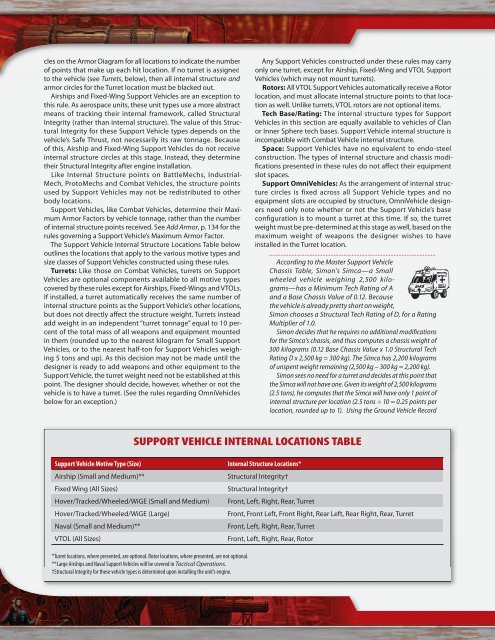the shape of things to come
the shape of things to come
the shape of things to come
You also want an ePaper? Increase the reach of your titles
YUMPU automatically turns print PDFs into web optimized ePapers that Google loves.
cles on <strong>the</strong> Armor Diagram for all locations <strong>to</strong> indicate <strong>the</strong> number<br />
<strong>of</strong> points that make up each hit location. If no turret is assigned<br />
<strong>to</strong> <strong>the</strong> vehicle (see Turrets, below), <strong>the</strong>n all internal structure and<br />
armor circles for <strong>the</strong> Turret location must be blacked out.<br />
Airships and Fixed-Wing Support Vehicles are an exception <strong>to</strong><br />
this rule. As aerospace units, <strong>the</strong>se unit types use a more abstract<br />
means <strong>of</strong> tracking <strong>the</strong>ir internal framework, called Structural<br />
Integrity (ra<strong>the</strong>r than internal structure). The value <strong>of</strong> this Structural<br />
Integrity for <strong>the</strong>se Support Vehicle types depends on <strong>the</strong><br />
vehicle’s Safe Thrust, not necessarily its raw <strong>to</strong>nnage. Because<br />
<strong>of</strong> this, Airship and Fixed-Wing Support Vehicles do not receive<br />
internal structure circles at this stage. Instead, <strong>the</strong>y determine<br />
<strong>the</strong>ir Structural Integrity after engine installation.<br />
Like Internal Structure points on BattleMechs, Industrial-<br />
Mech, Pro<strong>to</strong>Mechs and Combat Vehicles, <strong>the</strong> structure points<br />
used by Support Vehicles may not be redistributed <strong>to</strong> o<strong>the</strong>r<br />
body locations.<br />
Support Vehicles, like Combat Vehicles, determine <strong>the</strong>ir Maximum<br />
Armor Fac<strong>to</strong>rs by vehicle <strong>to</strong>nnage, ra<strong>the</strong>r than <strong>the</strong> number<br />
<strong>of</strong> internal structure points received. See Add Armor, p. 134 for <strong>the</strong><br />
rules governing a Support Vehicle’s Maximum Armor Fac<strong>to</strong>r.<br />
The Support Vehicle Internal Structure Locations Table below<br />
outlines <strong>the</strong> locations that apply <strong>to</strong> <strong>the</strong> various motive types and<br />
size classes <strong>of</strong> Support Vehicles constructed using <strong>the</strong>se rules.<br />
Turrets: Like those on Combat Vehicles, turrets on Support<br />
Vehicles are optional components available <strong>to</strong> all motive types<br />
covered by <strong>the</strong>se rules except for Airships, Fixed-Wings and VTOLs.<br />
If installed, a turret au<strong>to</strong>matically receives <strong>the</strong> same number <strong>of</strong><br />
internal structure points as <strong>the</strong> Support Vehicle’s o<strong>the</strong>r locations,<br />
but does not directly aff ect <strong>the</strong> structure weight. Turrets instead<br />
add weight in an independent “turret <strong>to</strong>nnage” equal <strong>to</strong> 10 percent<br />
<strong>of</strong> <strong>the</strong> <strong>to</strong>tal mass <strong>of</strong> all weapons and equipment mounted<br />
in <strong>the</strong>m (rounded up <strong>to</strong> <strong>the</strong> nearest kilogram for Small Support<br />
Vehicles, or <strong>to</strong> <strong>the</strong> nearest half-<strong>to</strong>n for Support Vehicles weighing<br />
5 <strong>to</strong>ns and up). As this decision may not be made until <strong>the</strong><br />
designer is ready <strong>to</strong> add weapons and o<strong>the</strong>r equipment <strong>to</strong> <strong>the</strong><br />
Support Vehicle, <strong>the</strong> turret weight need not be established at this<br />
point. The designer should decide, however, whe<strong>the</strong>r or not <strong>the</strong><br />
vehicle is <strong>to</strong> have a turret. (See <strong>the</strong> rules regarding OmniVehicles<br />
below for an exception.)<br />
Any Support Vehicles constructed under <strong>the</strong>se rules may carry<br />
only one turret, except for Airship, Fixed-Wing and VTOL Support<br />
Vehicles (which may not mount turrets).<br />
Ro<strong>to</strong>rs: All VTOL Support Vehicles au<strong>to</strong>matically receive a Ro<strong>to</strong>r<br />
location, and must allocate internal structure points <strong>to</strong> that location<br />
as well. Unlike turrets, VTOL ro<strong>to</strong>rs are not optional items.<br />
Tech Base/Rating: The internal structure types for Support<br />
Vehicles in this section are equally available <strong>to</strong> vehicles <strong>of</strong> Clan<br />
or Inner Sphere tech bases. Support Vehicle internal structure is<br />
incompatible with Combat Vehicle internal structure.<br />
Space: Support Vehicles have no equivalent <strong>to</strong> endo-steel<br />
construction. The types <strong>of</strong> internal structure and chassis modifi<br />
cations presented in <strong>the</strong>se rules do not aff ect <strong>the</strong>ir equipment<br />
slot spaces.<br />
Support OmniVehicles: As <strong>the</strong> arrangement <strong>of</strong> internal structure<br />
circles is fixed across all Support Vehicle types and no<br />
equipment slots are occupied by structure, OmniVehicle designers<br />
need only note whe<strong>the</strong>r or not <strong>the</strong> Support Vehicle’s base<br />
confi guration is <strong>to</strong> mount a turret at this time. If so, <strong>the</strong> turret<br />
weight must be pre-determined at this stage as well, based on <strong>the</strong><br />
maximum weight <strong>of</strong> weapons <strong>the</strong> designer wishes <strong>to</strong> have<br />
installed in <strong>the</strong> Turret location.<br />
According <strong>to</strong> <strong>the</strong> Master Support Vehicle<br />
Chassis Table, Simon’s Simca—a Small<br />
wheeled vehicle weighing 2,500 kilograms—has<br />
a Minimum Tech Rating <strong>of</strong> A<br />
and a Base Chassis Value <strong>of</strong> 0.12. Because<br />
<strong>the</strong> vehicle is already pretty short on weight,<br />
Simon chooses a Structural Tech Rating <strong>of</strong> D, for a Rating<br />
Multiplier <strong>of</strong> 1.0.<br />
Simon decides that he requires no additional modifi cations<br />
for <strong>the</strong> Simca’s chassis, and thus computes a chassis weight <strong>of</strong><br />
300 kilograms (0.12 Base Chassis Value x 1.0 Structural Tech<br />
Rating D x 2,500 kg = 300 kg). The Simca has 2,200 kilograms<br />
<strong>of</strong> unspent weight remaining (2,500 kg – 300 kg = 2,200 kg).<br />
Simon sees no need for a turret and decides at this point that<br />
<strong>the</strong> Simca will not have one. Given its weight <strong>of</strong> 2,500 kilograms<br />
(2.5 <strong>to</strong>ns), he computes that <strong>the</strong> Simca will have only 1 point <strong>of</strong><br />
internal structure per location (2.5 <strong>to</strong>ns ÷ 10 = 0.25 points per<br />
location, rounded up <strong>to</strong> 1). Using <strong>the</strong> Ground Vehicle Record<br />
SUPPORT VEHICLE INTERNAL LOCATIONS TABLE<br />
Support Vehicle Motive Type (Size) Internal Structure Locations*<br />
Airship (Small and Medium)** Structural Integrity†<br />
Fixed Wing (All Sizes) Structural Integrity†<br />
Hover/Tracked/Wheeled/WiGE (Small and Medium) Front, Left, Right, Rear, Turret<br />
Hover/Tracked/Wheeled/WiGE (Large) Front, Front Left, Front Right, Rear Left, Rear Right, Rear, Turret<br />
Naval (Small and Medium)** Front, Left, Right, Rear, Turret<br />
VTOL (All Sizes) Front, Left, Right, Rear, Ro<strong>to</strong>r<br />
*Turret locations, where presented, are optional. Ro<strong>to</strong>r locations, where presented, are not optional.<br />
**Large Airships and Naval Support Vehicles will be covered in Tactical Operations.<br />
†Structural Integrity for <strong>the</strong>se vehicle types is determined upon installing <strong>the</strong> unit’s engine.


